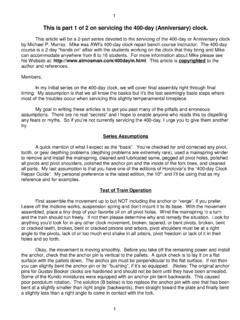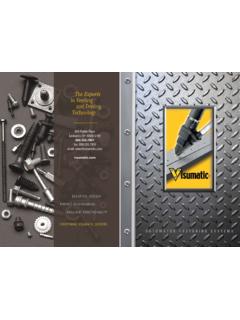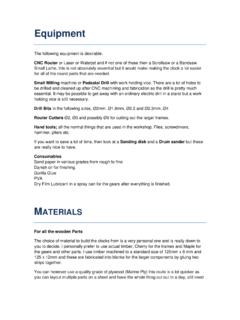Transcription of Bobs Clock Repair Trouble Shooting Notes - Tascione
1 bobs Clock Repair Trouble Shooting Notes by Bob Tascione Copyright (C) 2006, Bob Tascione Introduction: Following is a compilation of some common ailments encountered in Clock Repair . Although there are numerous reasons a Clock may not be performing well it's usually fairly easy to zero in on the main cause for the clocks failure. I need to explain here that the "main cause" is not always the only cause of a clocks problem. Often there will be several less obvious reasons. Addressing only the "main cause" by applying only one solution to effect Repair could be setting you or your customer up for more serious future problems. A clocks true problem may actually be comprised of the accumulation of many smaller ailments such as badly worn pivot holes, dirt, scoured pivots, scoured pallets, set mainspring etc.
2 A common example of this would be the 8 day Clock brought in due to premature stopping. After a good cleaning, oiling, bushing job and replacement of the old mainspring with a new one of the exact same dimensions the Clock still stops running after a couple of days. Upon further inspection the clockmaker notices that applying a small amount of pressure on the great wheel with his thumb gives the mainspring just enough extra power to get the Clock running again with good motion to the pendulum. He then determines that someone in the past must have inserted an improper mainspring of insufficient strength. His remedy? Insert a stronger mainspring of course. Although improper mainspring replacement is something you will see periodically it's not usually the case. Upon closer inspection this Clock would have revealed its true culprit; a bent pivot with additional scoured and grooved pivots.
3 In essence what the Clock maker has done is accelerate the wear and tear on the Clock by adding additional, unnecessary tension throughout the movements time train or worse set the movement up for a possibly disastrous scenario. If the bent pivot in this movement was weakened enough when the bending occurred it could possibly snap with this additional power stored in the movement. Snapping a pivot is not good. If things let loose in a fully wound you get the picture. keep in mind while reading the following list that it is in no way a complete anthology on Clock Repair remedies nor is it meant to be a Trouble Shooting list of exact causes with exact remedies for a given problem but is intended solely to help guide you towards the cause or causes of a problematic clocks ailments by giving you options to consider which will hopefully help narrow down your search.
4 It's for this reason that a Clock brought in for Repair should always be regarded as a restoration project not just a simple Repair job. Hand Problems: Let's cover some simple problems that can occur in the time train first. Some of these are pretty obvious. In this section we will assume the Clock is clean and that the mainspring or weight, whichever applies, is wound up. Bent or loosely fitted hands are common problems. If the Clock is stopping check the hands and make certain they are not catching on one another or dragging along the dial or glass during any part of their revolution around the dial. This can be caused by the movement being mounted crooked in the case, the case back being warped or the dial not being attached properly to the movement.
5 A tapered pin or retaining clip missing from a dial post, a loose or bent dial foot or a bent or otherwise distorted dial are sometimes at fault. Loose fitting, floppy minute hands are encountered often, especially on American clocks. You often find the square hole in the hand has either worn too large for the square on the minute post or an unsuitable replacement hand was used in the past. If the hands are a good fit but they move back and forth easily towards the dial then you probably need a new hand washer. These washers can be purchased in assortments from most supply houses. Try to get a good complete assortment as you will use them often. Also avoid stacking washers to get a good fit but rather try to find one washer of the correct thickness or cupped height to do the job.
6 It's amazing the percentage of clocks you will see that have been meticulously restored inside but are left with wobbly, badly fitted hands. A customer will interact with a Clock by winding the mainspring and by setting the hands. Imagine the impression left if the hands flop around during setting. Sympathetic Vibration: Another common problem is something called sympathetic vibration. To put it simply this is when energy from the movement is transferred to some external object. The external object can be the Clock case, table, wall, or floor depending on the location of the Clock . Theoretically this phenomenon always occurs to some extent, but when kept under control it is negligible. A timepiece is usually designed to deliver enough power to the escape wheel to keep the escapement and pendulum going with a bit left over for any small imperfections in the clocks construction and to allow for a certain amount of dirt and wear.
7 Sympathetic vibration will often sap enough of this energy to actually stop a Clock . You can see this vibration in action by placing a ticking mantle Clock on a table that is sitting on a thick carpet and then placing another stopped Clock on the same table next to it. After a few minutes you should see the stopped clocks pendulum swinging slightly. If you observe a floor Clock sitting on carpet that is not secured to the wall or to the floor beneath the carpet you will actually see the weights swinging in sympathy to the pendulum. When the weights have dropped down far enough to equal the length of the pendulum they will swing at their greatest amplitude. This is because the lengths are equal and at resonance. It's similar to holding two tuning forks that are tuned to the same frequency.
8 If you strike one the other will begin vibrating. You will encounter this problem regularly when doing service calls on tall case clocks. If the Clock is located on a carpeted floor it should also be secured to the wall or at least adjustable pointed case feet which poke through the carpet and hit the floor beneath should be used. If this isn't done the entire case will sway back and forth in unison with the pendulum. If you stand back and observe the Clock you can actually see this motion with reference to a point on the wall behind it. A significant amount of power is being spent to keep the case moving and since the movement was designed to swing the pendulum, not the Clock it will probably stop after a little dirt gets in there. Of course the same thing occurs if the Clock is on an uneven hard floor and the case feet are not adjusted to compensate for it.
9 You can see the importance of a Clock being secure on a wall, floor or sturdy table and that the movement is secure in its case. It's really all about energy conservation. After all, the power is intended to transfer from the train, through the escapement and ultimately to the pendulum. Which brings us Suspension springs: Here is another problem you will see often. A bent, kinked, twisted or torn suspension spring can cause a Clock to stop. If the spring looks damaged at all it should be replaced. If a Clock has a wobbly pendulum it is often caused by a twisted or partially torn spring. Like hand washers you can and should purchase a good assortment of suspension springs. There are different assortments available. American suspension springs come with the pendulum wire attached as one unit.
10 You only need to bend a hook shape at the end of the wire to hold the pendulum bob. When bending a wire pendulum for the bob the hook must be shaped so that the bob hangs in line with the wire. If it's off center it will also cause the bob to wobble. You will change suspension springs often so it's always good to have them on hand. If you need to order springs individually you will find that most suppliers use catalogs, some even online with pictures of springs to help match your damaged spring to. If you find that the suspension spring is in good shape and that the wheel train appears to deliver sufficient power to the escape wheel then your problem most likely lies somewhere in the escapement. Check that the crutch or crutch wire isn't too sloppy or too tight where it engages the pendulum for impulse.






